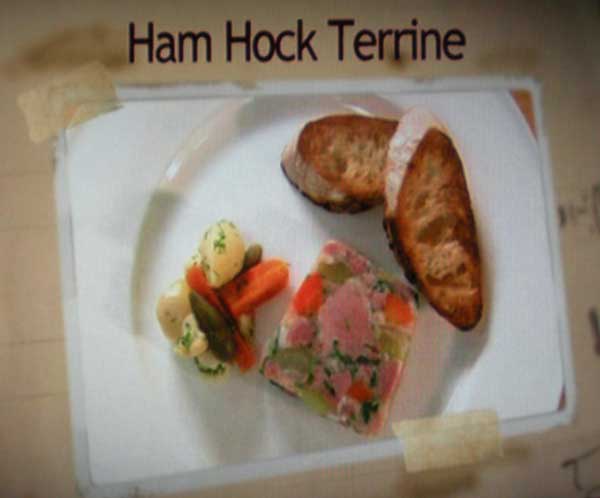Ham hock terrine and soused vegetables
Raymond Blanc’s rustic terrine not only looks and tastes fabulous, it is also low in fat, very economical and can be made days in advance. Serves 12
For the terrine
1.5kg/3lb 5oz ham hocks, either 1 large or 2 small
1 pig’s trotter, sliced down the length (optional; the trotter will add extra flavour as well as natural gelatine)
bouquet garni of 2 bay leaves, 2 sprigs fresh parsley and 1 sprig thyme
8 whole black peppercorns
1 large carrot, cut into 4 pieces
2 celery sticks, cut into 2 pieces
1 medium onion, peeled and cut into wedges
1½ leaves gelatine leaves, soaked in water
3 tbsp white wine vinegar
2 sprigs fresh flat leaf parsley, leaves only
For the soused vegetables
80ml/3fl oz white wine vinegar
4 tbsp clear honey
1 sprig fresh thyme
1 bay leaf
1 tsp salt
2 pinches freshly ground white pepper
160g/5½oz baby onions, peeled and with the root intact
100g/3½oz carrot, peeled and cut into 3cm/1¼in batons
70g/3oz cauliflower, cut into small florets
1 sprig fresh tarragon
60g/2½oz small gherkins, rinsed and drained
1 sprig fresh dill, chopped
For the terrine, place the ham hocks and trotter (if using) in a large pan and cover with 2 litres/3½ pints of cold water. Bring to a boil and boil hard for one minute, skimming away any impurities that rise to the surface – this will produce a nicely clear stock.
Turn the heat down to a gentle simmer, add the bouquet garni, peppercorns, carrot, celery and onion and cook, partially covered with a lid, for 3-4 hours or until the meat is tender enough to pull away from the bone. It is important to simmer very gently, with bubbles only just breaking the surface, to ensure the meat stays tender and the broth is clear. Add the vegetables about 45 minutes before the end of the cooking time.
While the meat is cooking, make the soused vegetables. Put 400ml/13½fl oz water, vinegar, honey, bay leaf, salt and pepper into a large pan and bring to a boil.
Add the onions and carrot to the pan, turn the heat down and simmer gently for 20 minutes.
Add the cauliflower and tarragon, simmer for a further ten minutes then remove the pan from the heat, add the gherkins and cool the mixture by plunging the base of the pan into a sink of cold water.
Once cooled, add the chopped dill and pour into a clean airtight jar. The vegetables can be kept in a fridge for up to two weeks.
When the meat is thoroughly cooked, strain the meat and vegetables through a sieve over a large bowl. Squeeze the soaking water from the gelatine, then stir the gelatine and vinegar into the stock and set aside.
Put the meat onto a large chopping board and set the vegetables aside. Peel the rind and fat from the meat then cut away and discard the fat. Chop the rind into 1cm/½in squares - they will help give the terrine a wonderful texture.
Cut away and reserve the three large pieces of meat following the grain of the muscles in the ham hocks. Flake the rest of the meat and the meat from the trotter and add it to the chopped rind.
Blanch the parsley for 15 seconds in a pan of boiling water, refresh in ice water to retain the colour, then drain on kitchen paper and chop roughly.
Roughly chop the vegetables and mix into the chopped parsley.
Line a terrine dish 23cm x 9cm x 8cm/9in x 3½in x 3in with two layers of cling film allowing a 10cm/4in overlap all around.
Layer the whole pieces of meat from the hocks into the terrine tin along with the vegetables and the meat/rind mixture, finishing with a layer of meat/rind to give the finished terrine a firm base. You shouldn’t need to season it because the ham will have had seasoning in its cure.
Press the mixture down and pour in the warm cooking liquor until it just covers the top layer. Make sure broth permeates layers. Any excess liquor can be used later for a deliciously simple soup or broth for noodles.
Fold over the cling film to cover the top of the terrine and press down gently once more. Place in the fridge for at least 12 hours.
To serve, carefully lift the terrine and cling film from the tin and wrap it tightly with two more layers of cling film. This will help to keep the shape and prevent the terrine falling apart as you cut it.
Place the terrine on the board with the meat/rind mixture on the bottom. Using a very sharp knife, slice the terrine into 12 slices and lay on to a flat serving dish, removing the cling film from each slice as you do so. Place the soused vegetables on the side of the plate or in a separate bowl and serve with a basket of freshly toasted bread – pain de campagne is ideal.
Tip
Pig’s ears and/or snouts could be cooked with the ham hocks then chopped and added to the terrine. This would give a lovely additional texture. The terrine can be served with many different accompaniments; pickled mushrooms or sauce gribiche would be particularly good.


